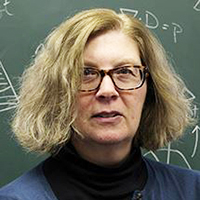By Elizabeth Greenspan
I recently received a proposal for a book titled A Hands-on Primer on Mathematical Methods in Materials Science by Maria Emelianenko, David Kinderlehrer, Patrick Shipman, and John Gemmer. I was excited; SIAM has not published many books in this important discipline, and a textbook that is accessible to undergraduate and graduate students would fill a void in both the literature and SIAM’s offerings. However, the manuscript received mixed reviews from referees. The problem concerned the audience — the book was meant to aid researchers and practitioners, as well as serve as a textbook for undergraduate and graduate students. As a result, it was not exactly a textbook but not quite a monograph either.
The authors proceeded to refine their vision and reconfigure the material, ultimately narrowing their primary audience to senior undergraduate and graduate students.
Know Your Audience
Authors of successful books (and sales are not the only measure of success) know their prospective readers and tailor content specifically to them. Manuscripts that lack a coherent point of view because the author did not identify the audience will likely receive negative reviews. Some questions to consider when determining one’s audience are as follows: Who comprises the intended audience? Is the text directed at researchers or students? If meant for the latter, for what level is it best suited? Textbooks come with their own sets of requirements, such as classroom exercises. Monographs should constitute more than a collection of papers, most of which your audience can probably already access — they are opportunities to synthesize one’s research and present a cohesive and coherent discussion on the topic at hand.
Publishers do not subscribe to the notion that all topics have been fully exhausted in existing literature. There is always room for another book or two (or three). That said, if a proposed book is intended for a market that falls within a crowded specialty or subspecialty (linear algebra, for example), it is important that the author’s approach differ from already-published manuscripts. He/she must provide readers with reasons to purchase the book. Daniela Calvetti of Case Western Reserve University elaborated on this requirement. “There are two thoughts that would make me consider writing a book,” she said. “One is to say something new and exciting that cannot be found in other books or easily grasped from articles, and the other is to propose a very different point of view on something that has been covered over and over.”
Instructing a class on a topic that lacks a proper textbook is another potential source of inspiration. “If I have a reliable book for a class I’m teaching, I would never dream of writing another one,” Calvetti continued. “But if I find myself having to put together the material from scratch time and again, then I may decide to convey that effort into writing a book.”
Submitting a Book Proposal
SIAM’s book proposal form requests information about the book’s aim, scope, and audience, and asks how it differs from existing texts on the topic. It also solicits details about the estimated length and number of figures.
While filling out the form can be tedious, senior researchers with multiple books under their belts vouch for its use. Seasoned authors admit that although some of the questions might seem obvious, the queries often raise issues about which they had not previously thought, thus helping to develop the book, focus their motivations, and refine their thinking.
In addition to the form, SIAM asks prospective authors to submit—at minimum—a preface and table of contents. This is a standard requirement for most publishers. While it is not necessary to finish a complete draft of one’s book before sending in a proposal, we do encourage prospective authors to submit at least one chapter because most reviewers want to base their evaluations on actual text rather than an abstract concept. This is especially true when the author does not have a lengthy publication history. Whether submitting one chapter or an entire book, authors should proofread the material carefully. Sloppy presentation frustrates some referees, causing them to dismiss an otherwise worthwhile manuscript.
Calvetti noted the benefits of finishing much of the text prior to submission. “I like to have a book very near completion before sending it to SIAM for consideration,” she said. “This way I am less likely to underestimate how long I will need to complete it, and the publication team will have a clearer idea of what the finished product will look like.”
Once the proposal—including the form and other necessary materials—is in hand, referees provide comments that are then passed along to the author; as with journal publishing, these reviewers are anonymous. SIAM reviews most books in their completed or nearly-complete form. Additionally, a manuscript is much more likely to be successful when looked at by someone other than the author prior to publication. Moreover, feedback helps authors further cultivate and improve their ideas.
“Why do I like writing books for SIAM?” Calvetti mused. “The organization is great to work with, has copyeditors who know their job very well, can accommodate cover artwork provided by the authors, and does a wonderful job advertising the books. The fact that I can elect to have part of the royalties go toward supporting student travel expenses to attend SIAM conferences is definitely a plus for me, as are the reasonable prices and substantially discounted rates for students.”
 |
Elizabeth Greenspan is the executive editor of SIAM Books. She is responsible for book acquisitions and the book program at SIAM. |